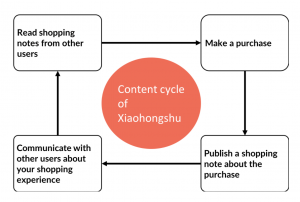
“Marking your life”

What is Xiaohongshu (Little Red Book)?
Xiaohongshu, born in June 2013, is a shopping software with community and shopping as its main functions. As a representative shopping software in the field of cross-border e-commerce, Xiaohongshu is different from traditional shopping software in that it operates not only as a shopping software with publicity, but also as a platform for user communication through its features. Its most famous is the establishment of a community for sharing quality notes, where users can find life hacks, quality lifestyle products, food preparation methods and so on.
In such a social platform that fits the psychology of young consumers, other users’ notes are more like product usage notes, including the quality of goods and shopping experience. After some users finish sharing their “show-off” notes, users who are also interested will follow suit. Such a chain reaction makes Xiaohongshu’s good quality content resources accumulate rapidly.
Xiaohongshu (Little Red Book) is not really a shopping platform at all.
It is fundamentally a content sharing site. Xiaohongshu’s internal design is very similar to Instagram: a small number of images, and text descriptions usually within 200 characters. The content style of the app is usually relaxed and free, usually with lots of emojis, and the level of content distribution is calculated by data. Users can interact with other users through features such as likes, favorites and comments.
“Xiaohongshu is not a cross-border e-commerce platform, but a product search engine,” declares Lauren Hallanan, a Chinese social media expert and vice president of direct broadcasting at The Meet Group (Borak, 2018).
Miro Li, co-founder of brand agency Double V, notes that “what makes this platform unique is the community and user experience.” He sees Little Red Book’s focus on connecting user-posted content to products – ecommerce’s passive waiting for users to show up does not do much for brands. “E-commerce is nothing without social apps.” (Borak, 2018)
Xiaohongshu held its anniversary event in June 2017 and exceeded 100 million RMB in sales revenue in just two hours, while the app also reached the number one download rate in the App Store for its rapid user growth shopping app. As of January 2019, the Xiaohongshu App has over 200 million users and is valued at over $3 billion (Dudarenok, 2018).
UGC content and KOL
Xiaohongshu is positioned as a cross-border e-commerce platform for UGC communities and overseas shopping. It uses overseas shopping sharing communities to attract and accumulate users, and transfers them to the shopping platform to achieve a complete business closure loop (van Dijck et al., 2018).

UGC
UGC (User Generated Content), which originated from the Internet, is in layman’s terms, users post and display their original content on the Internet platform, just like posting a blog or a Facebook message. -Users are both viewers and producers of content. In Xiaohongshu, a large number of users share “notes” every day, and in order to motivate users to do more UGC, Xiaohongshu has also built a user growth system, and the upgrade requirements include a large number of “content generation”.
This model is to mobilize the enthusiasm of Internet users to participate in the creation of videos, usually through the activities of companies to solicit video works related to the company (Terzi, 2011). In the past, the classification of UGC platforms focused on different fields and the boundaries were more closed, but now the boundaries of content focus and recommendation are gradually blurred, the UGC users’ own label identities are more diversified (food, skin care, travel), and the changes of users’ browsing habits are gradually in line with the psychological characteristics of women’s aimless shopping (Mitchell, 1992). The UGC approach allows users to find a sense of belonging in the platform, allowing more users to see a diverse range of products and creating a positive ecological environment.
KOL
KOL (Key Opinion Leader) is defined in marketing as a person who has more information about a product than the average user and is trusted by a group of fans and has a greater influence on the group’s purchasing behavior.
The KOLs of Xiaohongshu can be said to be a user hub of Xiaohongshu and the merchants, why how? KOLs play the role of “content fusion” in the process of brand communication, where information is collected, organized, and then diffused to users, forming the second transmission of information (Fang, 2017). In the Xiaohongshu platform, the link between KOLs and “traffic” is “UGC content”, i.e. Xiaohongshu notes, which usually carry the reality of the product. Especially the influential netizens and celebrities in the social media platform, using their strong influence, can show the product image to the fan base in the form of notes, and get very significant popularity and search volume for the brand and product from the social network.
Based on the fans’ recognition and trust in KOL, KOL can directly connect with users when recommending products, which increases the chance of selling products. From the psychology of fan behavior, what makes fans buy is the KOL’s “product” and what they use is the goods produced by the brand.
Xiaohongshu allows Chinese consumers to buy overseas products directly, so many global brands also translate their packaging into Mandarin and collaborate with Chinese KOLs. This includes Chanel, Gucci and Dior, who have all hired Chinese celebrities for their ads.
Because of the huge reach of Little Red Book KOLs, in 2018 global superstar Kim Kardashian opened an official account on Little Red Book and said in a low-key video, “I’m excited to open my official account and connect with my fans here (Smith, 2018).” Kardashian hopes to use her influence in a similar way to help her sell her beauty brand KKV in the Chinese luxury market.

Who is using Xiaohongshu?
Co-founder and CEO Wenchao Mao has said that 70% to 80% of Xiaohongshu’s users are women (Chen, 2021). It is the characteristics of these target groups that have contributed to Xiaohongshu’s original success.

It is the characteristics of these target groups that create superior innate conditions for Xiaohongshu’s original user accumulation and UGC content construction. Secondly, Xiaohongshu plays the advantage of user sharing, and the main group of cross-border e-commerce consumers is young people. They tend to rely on word-of-mouth from celebrities, shopping experts and friends and relatives (Fang, 2017). Even if they do not intend to go abroad, they still want to get some information and shopping experience about overseas products more conveniently.
Xiaohongshu, with its own community characteristics, brings different groups closer together and enhances consumers’ sense of belonging and trust. In addition, Xiaohongshu has also reflected its precise community positioning on its online community website, and its characteristic page layout design and creative topics of conversation have promoted users’ participation and activity, which has increased consumers’ stickiness to a certain extent.
Platform Revenue Sources
The current profit model of Xiaohongshu is mainly based on the fact that users generate at least 3,000 notes per day and use the process of shopping to earn the difference in price of products. It is only the unusual optimization and choices made by Xiaohongshu in the pathway from the user to the product that has led to an increasingly diverse path of development (Borak, 2018). Second, Little Red Book has introduced a membership system that charges a fixed annual fee. Consumers get exclusive member prices on products, not only free shipping, priority purchase on limited items, and other membership privileges. Although this can be profitable, but the fee is more as an auxiliary means to increase user stickiness, moreover, this can bring more potential users to spend (Mitchell, 1992). Of course, Xiaohongshu needs to develop more diversified profit models in order to make further profits and to develop better.
Problems of the operation model
Trust crisis.
- The platform is accused of selling and counterfeiting. Mitchell (1992) points out that there are many risks affecting consumers’ online shopping, including trust, virtual experience, and involvement. Since the strong user demand cannot be met, Little Red Book has to choose to compromise with third-party channel providers, and this undoubtedly greatly increases the risk of counterfeit goods. In addition, some consumers said that the quality of the products purchased from Xiaohongshu was problematic, and the request for return was rejected; Xiaohongshu responded that the platform has a mature monitoring mechanism for the sources and channels of goods, and that the quality of goods is only due to the difference between the many origins of goods and printing. But this statement does not make users satisfied.
- Lack of authenticity of UGC content. As users overly pursue the exposure rate of the posted content, they beautify the photos of the scenic spots they share by PS method. (Take the picture below for example)This makes notes with a high number of views become almost a dailyoperation of PS masters. The problem of “distortion” still has a negative impact on the brand image ofXiaohongshu.

Conclusion
In the competitive e-commerce platform market, Xiaohongshu has opened a new model of UGC business with community as the entry point, and formed a complete business loop from community to e-commerce. With the rise of overseas shopping in recent years, the number of customers with overseas shopping needs is increasing day by day. However, “what to buy” and “where to buy” are the most important issues for consumers. The emergence of Xiaohongshu has solved these two problems. In Xiaohongshu’s UGC community, users can share their own shopping experiences and easily find shopping tips they are interested in, which is the real success of Xiaohongshu.
Watch the video to learn more about Xiaohongshu
References
Borak, M. (2018). The Little Red Book is a social e-commerce platform that’s not an e-commerce platform at all · TechNode. TechNode. Retrieved 17 October 2021, from https://technode.com/2018/09/29/xiao-hong-shu-little-red-book/.
Chen, T. (2021). Little Red Book (Xiaohongshu) Marketing – A Complete Guide. WalktheChat. Retrieved 17 October 2021, from https://walkthechat.com/Xiaohongshu-Little-Red-Book-fostering-e-commerce-via-word-Mouth/.
Dudarenok, A. (2018). How to launch your product on China’s popular Xiaohongshu fashion platform. TNW | Contributors. Retrieved 17 October 2021, from https://thenextweb.com/news/how-to-launch-your-product-on-chinas-popular-xiaohongshu-fashion-platform.
Fang, Y. (2017). Current Situation, Obstacles and Solutions to China’s Cross-Border E-Commerce. Open Journal Of Social Sciences, 05(10), 343-351. https://doi.org/10.4236/jss.2017.510028
Mitchell, V. (1992). Understanding Consumers’ Behaviour: Can Perceived Risk Theory Help?. Management Decision, 30(3). https://doi.org/10.1108/00251749210013050
Smith, T. (2018). All Atwitter in China: Kim Kardashian Joins Social Media Beauty Site ‘Little Red Book’ | Jing Daily. Jing Daily. Retrieved 17 October 2021, from https://jingdaily.com/kim-kardashian-red-book/.
Terzi, N. (2011). The impact of e-commerce on international trade and employment. Procedia – Social And Behavioral Sciences, 24, 745-753. https://doi.org/10.1016/j.sbspro.2011.09.010
van Dijck, J., Poell, T., & de Waal, M. (2018). The Platform Society. Oxford Scholarship Online. https://doi.org/10.1093/oso/9780190889760.001.0001
<a rel=”license” href=”http://creativecommons.org/licenses/by/4.0/”><img alt=”Creative Commons License” style=”border-width:0″ src=”https://i.creativecommons.org/l/by/4.0/88×31.png” /></a><br />This work is licensed under a <a rel=”license” href=”http://creativecommons.org/licenses/by/4.0/”>Creative Commons Attribution 4.0 International License</a>.